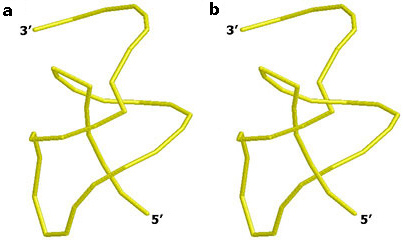Knots are objects in three-dimensional space. In the physical world, we make a knot from a piece of rope or string that has two ends. If you pull on the ends, the topology remains unchanged no matter how much you twist or pull. The simplest knot is the overhand knot (Fig. 1). You can form an overhand knot by making a loop in a piece of cord and pulling the end through it.

Knots are characterized by their number of inner crossings. For example, the overhand knot has three crossings (Fig. 1a). In the absence of a 3D perspective, we cannot tell whether the strand forms a loop or an overhand knot (Fig. 1b). The term pseudoknot comes from the 'knotted' appearance of flat diagrams of RNA secondary structure. However, the perspective in the Chime model of the SRV-1 RNA 'pseudoknot' shows that the structure isn't a knot (Fig. 2a). Pull on the ends in your imagination and the RNA strand straightens out. Or you can play with the opening Chime model of the SVR-1 RNA pseudoknot. Figure 2b depicts an unorthodox structure for RNA, namely an overhand knot.
